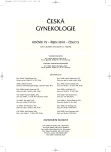Forceps delivery - an outdated obstetric technique?
Authors:
A. Pařízek
Authors‘ workplace:
Gynekologicko-porodnická klinika 1. LF UK a VFN, Praha, přednosta prof. MUDr. A. Martan, DrSc.
Published in:
Ceska Gynekol 2010; 75(5): 408-416
Overview
The use of forceps delivery has been at the height of obstetric methods for centuries. They have even been described as „royal“, since from the time of their discovery they have helped solve even the most difficult delivery problems. In the past couple of decades, however, the use of alternative delivery tools, especially the vacuum extractor, have become more widespread during vaginal deliveries.
The aim of this paper is to evaluate the current status of the use of forceps delivery and compare them with vacuum extraction, another tractive method. Published data, particularly from the Cochran database, are supplemented by personal experience.
Key words:
forceps delivery, vaginal deliveries, vacuum extractor.
Sources
1. Doležal, A. Porodnické operace. Praha: Grada Publishing, 2007. p. 153–193.
2. Malmström, T. Vacuum extractor: an obstetrical instrument. Gothenburg, Sweden: Northern Association of Obstetrics and Gynaecologists, 1954, p 1–32.
3. Vacca, A. Vacuum-assisted delivery: an analysis of traction force and maternal and neonatal outcomes. Aust N Z J Obstet Gynaecol, 2006, 46(2), p. 124–127.
4. The Royal College of Obstetricians and Gynaecologists. Instrumental vaginal delivery. London, UK: The Royal College of Obstetricians and Gynaecologists, 2000, (Clinical Green Top Guideline no. 26)
5. Martin, JA., Hamilton, BE., Sutton, PD., et al. Births: Final Data for 2004. Natl Vital Stat Rep, 2006, 29, 55(1), p. 1–101.
6. Chervenak, J. Overview of professional liability. Clin Perinatol, 2007, 34(2), p. 227–232.
7. Towner, D., Castro, MA., Eby-Wilkens, E., Gilbert, WM. Effect of mode of delivery in nulliparous women on neonatal intracranial injury. N Engl J Med, 1999, 341(23), p. 1709–1714.
8. ACOG Committee on Practice Bulletins. Operative vaginal delivery. ACOG Practice Bulletin, 2000, 17, p. 1–8.
9. Roshan, DF., Petrikovsky, B., Sichinava, L., et al. Soft forceps. Int J Gynaecol Obstet, 2005, 88(3), p. 249–252.
10. Johanson, R., Menon, V. Soft versus rigid vacuum extractor cups for assisted vaginal delivery. Cochrane Database Syst Rev, 2000, (2): CD000224.
11. Bhide, A., Guven, M., Prefumo, F., et al. The maternal and neonatal outcome after failed ventouse delivery: comparison of forceps versus cesarean section. J Matern-Fetal Neonatal Med, 2007, 20(7), p. 541–545.
12. Williams, MC., Knuppel, RA., O’Brien, WF., et al. Obstetric correlates of neonatal retinal hemorrhage. Obstet Gynecol, 1993, 81(5 (Pt 1), p. 688–694.
13. Whitby, EH., Griffiths, PD., Rutter, S., et al. Frequency and natural history of subdural haemorrhages in babies and relation to obstetric factors. Lancet, 2004, 363, p. 846–851.
14. Towner, DR., Ciotti, MC. Operative vaginal delivery: a cause of birth injury or is it? Clin Obstet Gynecol, 2007, 50(3), p. 563–581.
15. Suwannachat, B., Lumbiganon, P., Laopaiboon, M. Rapid versus stepwise negative pressure application for vacuum extraction assisted vaginal delivery. Cochrane Database Syst Rev. 2008, 16(3): CD006636.
16. Liabsuetrakul, T., Choobun, T., Peeyananjarassri, K., Islam, M. Antibiotic prophylaxis for operative vaginal delivery. Cochrane Database Syst Rev. 2004, (3): CD004455.
17. Miksovsky, P., Watson, WJ. Obstetric vacuum extraction: state of the art in the new millennium. Obstet Gynecol Surv, 2001, 56(11), p. 736–751.
18. Zwinger, A., et al. Porodnictví. Praha: Galén 2004.
19. Roztočil, A., et al. Moderní porodnictví. Praha: Grada Publishing, 2008.
20. Větr, M. Trendy ve vývoji operačních porodů. Čes Gynek, 2009, 74(5), p. 355–359.
21. Čech, E., Hájek, Z., Maršál, K., et al. Porodnictví. Praha: Grada Publishing, 2006.
22. URL: <http://emedicine.medscape.com/article/263603-media> [Updated: Jun 3, 2010]
23. Hájek, Z., et al. Rizikové a patologické těhotenství. Praha: Grada Publishing, 2004.
24. Akmal, S., Kametas, N., Tsoi, E., et al. Comparison of transvaginal digital examination with intrapartum sonography to determine fetal head position before instrumental delivery. Ultrasound Obstet Gynecol, 2003, 21, p. 437–440.
25. al-Suhel, R., Gill, S., Robson, S., Shadbolt, B. Kjelland’s forceps in the new millennium. Maternal and neonatal outcomes of attempted rotational forceps delivery. Austr New Zealand J Obstet Gynaecol, 2009, 49, p. 510–514.
26. Krofta, L., Otčenášek, M., Kašíková, E., Feyereisl, J. Pubococcygeus–puborectalis trauma after forceps delivery: evaluation of the levator ani muscle with 3D/4D ultrasound. Int Urogynecol J 2009, 20, p. 1175–1181.
27. Nuss, R., Hathaway, WE., Vacca, A., Towner, D. Effect of mode of delivery on neonatal intracranial injury. N Engl J Med, 2000, 342, p. 892–893.
28. Gopalani, S., Bennett, K., Critchlow, C. Factors predictive of failed operative vaginal delivery. Am J Obstet Gynecol, 2004, 191(3), p. 896–902.
29. al-Kadri, H., Sabr, Y., al-Saif, S., et al. Failed individual and sequential vaginal delivery: contributing risk factors and maternal–neonatal complications. Acta Obstet Gynecol Scand, 2003, 82, p. 642–648.
30. Molina, FS., Nicolaides, KH. Ultrasound in labor and delivery. Fetal Diagn Ther, 2010; 27, p. 61–67.
31. Simkin, P. The fetal occiput posterior position: state of the science and a new perspective. Birth, 2010, 37(1), p. 61–71.
32. Hale, TM., Shi, Z., Idangodage, H., et al. A new obstetrical polyurethane versus stainless steel forceps: a comparison of forceps generated to the base of the fetal skull during simulated deliveries. J Perinat Med, 2009, 37(6), p. 669–671.
33. Dupuis, O., et al. A new obstetric forceps for the training of junior doctors. Am J Obstet Gynec, 2006, 194(6), p. 1524-1531.
34. Schaub, AF., Litshgi, M., Hoesli, I., et al. Obstetric gel shortens second stage of labor and prevents perineal trauma in nulliparous women: a randomized controlled trial on labor facilitation. J Perinat Med, 2008, 36, p. 129–135.
Labels
Paediatric gynaecology Gynaecology and obstetrics Reproduction medicineArticle was published in
Czech Gynaecology

2010 Issue 5
Most read in this issue
- Laboratory and clinical indicators of the state of the newborn after birth
- Vacuumextraction
- Lesions of peripheral nerves in obstetrics and gynecology. A review
- The efficiency of oral contraception containing drospirenone in treating symptoms of premenstrual syndrome or premenstrual dysphoric disorder in gyneacology practice
